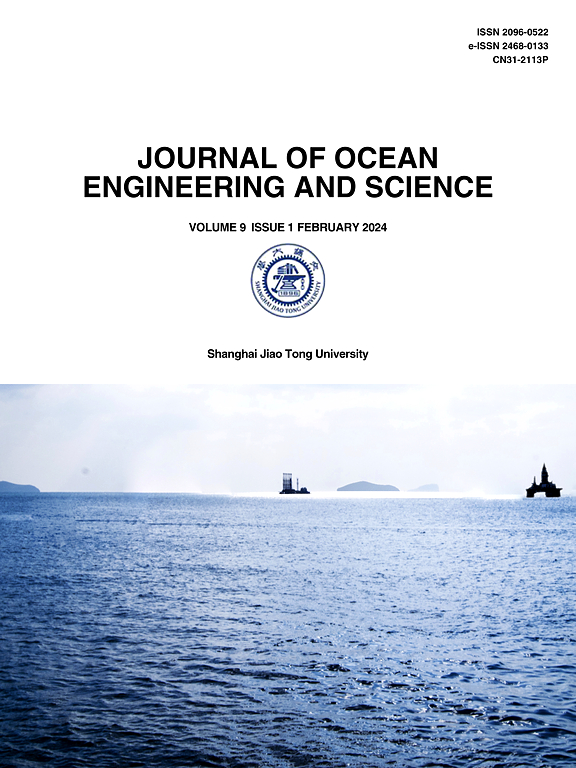An experimental study on wave run-ups of fixed four-rounded-square-column array in focused waves
IF 11.8
1区 工程技术
Q1 ENGINEERING, MARINE
引用次数: 0
Abstract
The wave run-up along the column surface is one of the focal issues of research in ocean engineering. This experimental study aimed to reveal the wave run-up characteristics of a fixed four-square-column array with rounded corners under focused waves by controlling wave steepness, spectral peak period, wave direction, and focus position. The experiment utilized a 1:50 scale physical model, with focused waves generated in a wave tank to simulate extreme sea conditions. Four squared columns were fixed to the tank carriage. Eighteen wave probes were installed around the fore and rear columns to measure wave run-ups. The results indicated that with an increase in wave steepness, the wave run-up ratio demonstrates an increasing trend, particularly when the waves approach or precisely break at the focal point. Furthermore, the wave run-up ratio on the front column decreases as the spectral peak period increases, owing to the weakening of the nonlinear wave-column interaction when the wavelength is significantly larger than the column width. For the rear column, the dissipation of wave energy by the front column leads to a notably lower wave run-up ratio. However, under the influence of incident focused waves at certain wavelengths, the rear column may experience a more intense secondary run-up phenomenon. Additionally, comparative analysis of different focus positions revealed that the wave run-up ratio is maximized when the focus position is located behind the front column. The incident waves at 45° were diffracted by the rounded corners of the columns, leading to the dispersion of wave energy and consequently yielding a reduced wave run-up ratio. The experimental data obtained serve as crucial benchmarks for validating further numerical simulations of wave impact on rounded square columns.
固定四圆方柱阵在聚焦波中波动的实验研究
波浪沿柱面运动是海洋工程研究的热点问题之一。本实验研究通过控制波陡度、谱峰周期、波方向和聚焦位置,揭示了固定四方柱圆角阵列在聚焦波作用下的波速特性。该实验利用1:50比例的物理模型,在波浪槽中产生聚焦波来模拟极端的海洋条件。四根方柱固定在坦克车厢上。前后柱周围安装了18个波浪探头来测量波浪的上升。结果表明,随着波浪陡度的增大,波浪上升比呈增大趋势,特别是当波浪接近或恰好在焦点处破裂时。此外,随着谱峰周期的增加,前柱上的波速比减小,这是由于波长明显大于柱宽时,非线性波柱相互作用减弱所致。对于后柱而言,前柱对波能的耗散导致波浪爬升比明显降低。但在特定波长入射聚焦波的影响下,后柱可能会出现更强烈的二次爬升现象。不同聚焦位置的对比分析表明,当聚焦位置位于前柱后方时,波的爬升比最大。45°入射波被圆柱的圆角衍射,导致波能量的弥散,从而降低了波的上升比。所获得的实验数据为进一步验证波浪对圆方柱冲击的数值模拟提供了重要的基准。
本文章由计算机程序翻译,如有差异,请以英文原文为准。
求助全文
约1分钟内获得全文
求助全文
来源期刊

Journal of Ocean Engineering and Science
Multiple-
CiteScore
11.50
自引率
19.70%
发文量
224
审稿时长
29 days
期刊介绍:
The Journal of Ocean Engineering and Science (JOES) serves as a platform for disseminating original research and advancements in the realm of ocean engineering and science.
JOES encourages the submission of papers covering various aspects of ocean engineering and science.
 求助内容:
求助内容: 应助结果提醒方式:
应助结果提醒方式:


